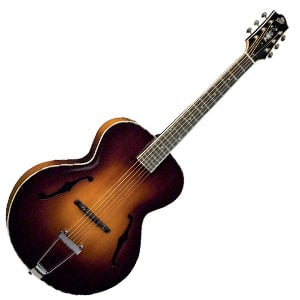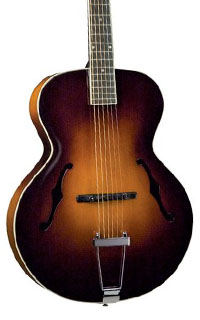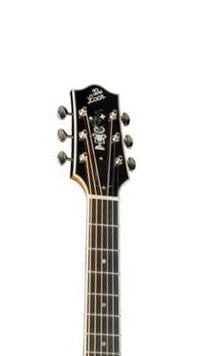- Home
- Instruments
- Gear
- Recording
- Lessons
- Reviews
- Blog


| Body And Neck: |  |
| Hardware: |  |
| Sound: |  |
| Value: |  |
Unlike some of the more iconic high-end guitar brands, The Loar tend to fall a little under the radar. However, they are well worth paying attention to, as this Chinese manufacturer focus on paying homage to and reviving instruments from the Golden Age of guitar (the 1920s and 1930s), which The Loar declare was ‘an age of outstanding craftsmanship and innovative design’.
And we’re inclined to agree – especially when you see something like the beautiful LH-700 Archtop, which comes in at just under $1500. It’s not cheap, but it’s not your everyday guitar. Time to find out what makes it so different, and whether it’s worth the cash.

As the name reveals, the LH-700 is an archtop guitar with a scale length of 24.75”, and features a solid top that’s hand-carved and hand-graduated from AAA-grade spruce. This top has no round sound hole – instead sporting two hand-carved F holes on either side of the bridge. Sticking with the high-quality wood theme, the back and sides of this guitar are made from solid AAA-grade flamed maple, with the entire body finished in a dark tobacco staining and hand-buffed nitrocellulose lacquer, which certainly helps achieve the vintage look and sound The Loar are going for.
There’s a highly-glossed single-piece figured maple neck with a vintage V profile, along with a bound ebony fretboard, 19 frets, and mother-of-pearl dot inlays. The craftsmanship is overall decent – it’s not quite comparable to the quality of a Taylor, Martin or even Takamine in this price range, and you may find a few little flaws here and there, but generally the guitar feels well-made.

This is a solely acoustic model, so there are no electronics to discuss. However the hardware is both quality and appropriate for the style. The elaborately decorated headstock features six gold Grover Sta-Tite open-geared tuners, with a smooth 18:1 gear ratio and butterbean style tuning keys. There’s a compensated adjustable ebony bridge, with a floating, trapeze-style tailpiece, and a standard bone nut. Finally, the guitar is shipped with a rugged hardshell archtop case with a plush interior, which is a welcome extra.
This archtop can really make itself heard – in fact, maybe a little too much! The solid woods are all excellent quality, and resonate extremely well, leading to a guitar that will cut through any mix with a sparkly voice – perfect for playing with groups and vocalists. The spruce leads to a mellow and balanced sound, but with plenty of brightness when needed, while the maple back and sides help project the tone clearly. A sweet sounding guitar, that’s hard to fault.
The LH-700 certainly won’t appeal to everybody, and The Loar have some catching up to do when it comes to quality control, but the timeless look and huge vintage sound combine to make this a very interesting guitar indeed. For jazz players with a penchant for 30s jazz in particular, this could well be your perfect guitar. The price is pretty high, but we feel that overall the LH-700 justifies it.
For more info about the The Loar LH-700 Archtop, click here.
For more acoustic guitar under $1500 you might like, click here.

Adrian Woods says
If you are shopping for an affordable solid-wood archtop and have started researching the Loar LH-700, this review (not sure if this reviewer is selling this, or a neutral party?) gives you some reasonably accurate information, but not the full picture. Design-wise, it’s not just “paying homage to…the Golden Age of guitar (the 1920s and 1930s)”–an period that saw quite an evolution in archtop design from beginning to end–but rather, zeroing in on one particular design, the Gibson L-5 of the late 1920s. This Gibson design had a 16″ body with parallell bracing, which in turn produced a sound very different from the L5s of a few years later, which had 17″ bodies and X bracing. The smaller model of the late 20s (the model The Loar is aiming for) has a brighter sound and a bit less deep bass response.
This review says “[t]he spruce [top] leads to a mellow and balanced sound…” Actually, that’s not true. Compared to flat-top acoustic guitars, which outnumber archtop acoustics by about a million to one, there is nothing mellow sounding about the LH-700. You can play it more gently and pick nearer the neck with a thick pick, and you will get a *less* bright and clangy sound (especially with judicious palm muting from your picking hand), but you aren’t going to get what the average guitarist would think of as a mellow acoustic sound (e.g. the sound of a high-end rosewood and spruce dreadnought, or the sound of a fine classical guitar). The Gibson L-5 was designed to have a laser-focused mid-range sound that would cut through a small orchestra (this was the age before electric guitar amplification), and that’s exactly what this thing can do. It sounds like a big six-stringed mandolin, because that’s exactly how it’s constructed…maple back and sides, carved arch top.
If you are comparing guitars from The Loar to those from Eastman, know that Eastman acoustic archtops use X bracing, and will therefore have a more subdued tone than the parallel-braced Loars (which will sound more like Selmer-style Gypsy Jazz guitars in comparison). They are two different beasts, and the Eastmans will probably appeal more to bebop and mainstream jazz players, while the Loars will appeal more to swing, blues and ragtime musicians.
Lastly, while this review mentions that The Loar is manufactured in China, it doesn’t mention that the guitar was conceived and designed in California by vintage guitar buffs who know the history, strengths and weaknesses of the old Gibson designs that they are starting from. And this review calls the hardshell case “rugged” and implies that it’s a high-quality case; it’s actually kind of cheaply made and not all that rugged (though not terrible). If you buy an LH-700, set aside a couple of hundred bucks to get a professional set up and fret-leveling done by an experienced guitar shop…it will make a huge difference in playability and sound for this guitar.